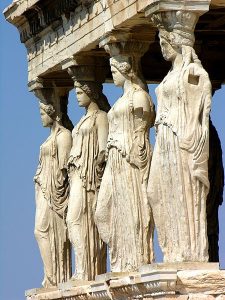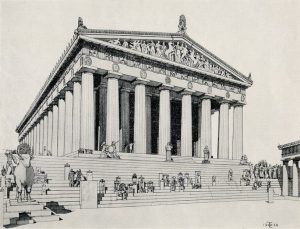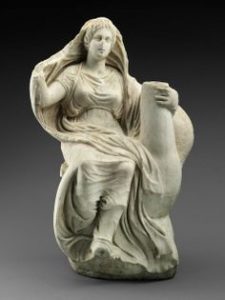The classical age time period of Greece begins with the Persian War (490-479 B.C.) after the end of the Archaic age and ends with the death of Alexander the Great (323 B.C.) which was then followed by the Hellenistic.
It was a period of about 200 years which is considered to be the peak of Greek culture in which saw the emergence of democracy, the wars with the Persians and even within the two most powerful states in ancient Greece. Besides war and conquest, in this period of Ancient Greece, the Greeks produced great literature, poetry, philosophy, drama, and art. Greek Classical Period includes the period known as the Age of Pericles. During this age art and architecture flourished. There was economic prosperity and the people could put their minds to the development of art. Athens was the center of learning. The theatre gained importance and was a popular source of entertainment.

Greek Classical Period
During the era before the Classical Age, in what is sometimes called the Archaic Age, Athens and Sparta had followed different paths. Between 480 and until 323 BCE Athens and Sparta dominated the Hellenic world with their cultural and military achievements.
These two cities, with the involvement of the other Hellenic states, rose to power through alliances, reforms, and a series of victories against the invading Persian armies. One of the unique contributions of the Greeks, democracy lasted beyond the Classical period and had its roots in the earlier time, but it still characterized the Classical age.
The Classical Period produced remarkable cultural and scientific achievements. The city of Athens introduced to the world a direct democracy the likes of which had never been seen hitherto, or subsequently, with western governments like Great Britain, France, and the USA emulating it a thousand years later.
Classical Greek political structures
The 200 years between the 5th and 4th century BC is when Greek culture reached its peak with great inventions in scientific fields and great intellectual discourses in philosophy, art and literature. It also signaled the rise of democracy in ancient Greece.
When the public became aware of the downsides of tyranny, they wanted more political rights and at this moment a system of direct democracy was established in Athens.
Athens was the most popular state with its ‘egalitarian’ democracy but the period saw even other states sharing atleast some power with the masses. Popular assemblies were established which allowed the public to share certain political power. States like Magara and even Sparta had such assemblies.
Despite the egalitarian councils getting popular in this period, there were still countries that were ruled by oligarchs and despised the sharing of power with the masses. The Peloponnesian powers were mainly ruled by oligarchies or monarchs who were hostile to the democratic rule of Athens which led them to the Peloponnesian war.
Classical Ancient Greek literature
Philosophy
The classical period can be termed the golden age of Greek philosophy with ancient Athens emerging as a hub of intellectual discourses.
Classical Architecture
Classical Greek architecture was best known for its rectangular design framed by Colonaddes open on all sides and it emphasized formal unity.
There grew three architectural Greek orders with distinct styles namely: the Doric, the Ionic, and the Corinthian.
The Doric order used simple, smooth, or fluted columns with circular capital and the entablature firing a decorative element above the columns. The Ionic columns used volutes, a decorative element at the top of the capital, and the entablature is so designed that a narrative freeze extended the length of the building and the late Corinthian order was the most decorative by using elaborately carved capitals and an acanthus leaf motif. These had profound effects on Roman architecture as well as modern western architecture.
The influence of Greek Classical architecture can be seen in renaissance architecture like in the dome of Florence, and even in modern buildings like the US capitol.

Classical Greek art
The art of Greece Classical Period began the trend towards a more naturalistic (even in its early idealistic state) depiction of the world, thus reflecting a shift in philosophy from the abstract and supernatural to more immediate earthly concerns.
Artists stopped merely suggesting the human form and began describing it with accuracy. The man became the focus, and measure of all things in daily life through Democratic politics, and in cultural representations. Rational thinking and Logic became the driving force behind this cultural revolution at the expense of emotion and impulse.
It was the first time in human history that the human body was studied for its aesthetic values, and was treated as an autonomous universe. The object of art became the human itself as the focus of the artist revolved around ordinary subjects like the the weight shift during the forward step at the moment before the release of the thunder, the tying of a ribbon around one’s head, or just the shift of the pelvis when one leg supports the man’s weight.

The Greek Classical Period ends with the death of Alexander the Great in 323 B.C. Besides war and conquest, in the Classical period, the Greeks produced great literature, poetry, philosophy, drama, and art. This was the time when the genre of history was first established. It also produced the institution we know of as Athenian democracy.
How did Hellenistic sculpture differ from classical sculpture in ancient Greece?
The classical period focused much more on accurate representation of the human body. While the Hellenistic sculptures captured the emotional side of humans in their portraits.
The classical portraits are more idealized and static while the Hellenistic sculptures depict dramatic features like anger, happiness, sadness, etc.
The classical period concerned itself with more religious or natural themes while the Hellenistic period was more of a dramatic expression of the spiritual aspects.
The Hellenistic period sculptures also did not follow a rigid form or tiles and were more open to experiments.
Timeline of Classical Greece
Democracy established in Athens
Athens had first overthrown their tyrant with the help of the spartans who installed an oligarchy headed by Isagoras. But around 508 BC, Cleisthenes with public support reformed the Athenian constitution to give more rights to the citizens and established a direct democracy. It was the first of its kind where the public decided the policies of the state by voting and debates.
The Persian invasions
The Persians under Darius the Great invaded the Greek lands around 490 BC and were defeated by the Greeks in the famous battle of the Marathon.
But the Persians were back under Xerxes with a larger force to conquer almost the whole of southern Greece. Athens was burned, although they had evacuated the city beforehand. The battle turned with the battle of Thermopylae, where a group of 300 spartan soldiers held the Persians for a long time before the Persian fleet was destroyed in the Battle of Salamis.
The Greeks formed a Confederate known as the Hellenic league to fight the Persians. Athens took the lead to even freeing the Greek states from Persian control to finally get rid of the Persians.
The Peloponnesians wars
Rise of Macedonia
Macedonia which was known for its fighting skills rose to prominence under Philip II from 360 BC. He modernized the army and made great innovations in tactics. He managed to bring a large portion of the Greek territories under his control.
Although he ruled a large number of Greek states it was mainly with the rise of Alexander that they were consolidated under the Macedonian throne. He managed to join the majority of Greek states under his rule before turning toward the Persians. He managed to build the largest empire known in history which stretched up to the northwest part of the Indian subcontinent. His death signalled the end of the classical period.
More info on- Hellenistic period Greece